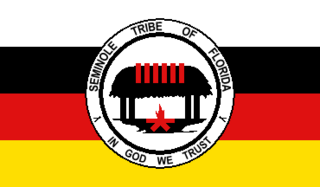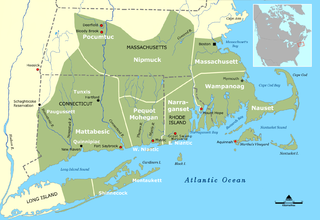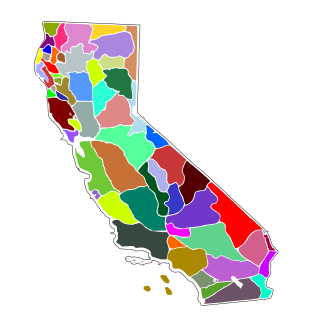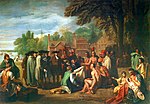The Seminole are a Native American people who developed in Florida in the 18th century. Today, they live in Oklahoma and Florida, and comprise three federally recognized tribes: the Seminole Nation of Oklahoma, the Seminole Tribe of Florida, and Miccosukee Tribe of Indians of Florida, as well as independent groups. The Seminole people emerged in a process of ethnogenesis from various Native American groups who settled in Spanish Florida beginning in the early 1700s, most significantly northern Muscogee Creeks from what is now Georgia and Alabama.
Uncasville is an area in the town of Montville, Connecticut, United States. It is a village in southeastern Montville, at the mouth of the Oxoboxo River. The name is now applied more generally to all of the east end of Montville, which is the area served by the Uncasville ZIP Code.

The Nonintercourse Act is the collective name given to six statutes passed by the Congress in 1790, 1793, 1796, 1799, 1802, and 1834 to set Amerindian boundaries of reservations. The various Acts were also intended to regulate commerce between settlers and the natives. The most notable provisions of the Act regulate the inalienability of aboriginal title in the United States, a continuing source of litigation for almost 200 years. The prohibition on purchases of Indian lands without the approval of the federal government has its origins in the Royal Proclamation of 1763 and the Confederation Congress Proclamation of 1783.
Seminole Tribe of Florida v. Florida, 517 U.S. 44 (1996), was a United States Supreme Court case which held that Article One of the U.S. Constitution did not give the United States Congress the power to abrogate the sovereign immunity of the states that is further protected under the Eleventh Amendment. Such abrogation is permitted where it is necessary to enforce the rights of citizens guaranteed under the Fourteenth Amendment as per Fitzpatrick v. Bitzer. The case also held that the doctrine of Ex parte Young, which allows state officials to be sued in their official capacity for prospective injunctive relief, was inapplicable under these circumstances, because any remedy was limited to the one that Congress had provided.
The Mohegan are an Algonquian Native American tribe historically based in present-day Connecticut. Today the majority of the people are associated with the Mohegan Indian Tribe, a federally recognized tribe living on a reservation in the eastern upper Thames River valley of south-central Connecticut. It is one of two federally recognized tribes in the state, the other being the Mashantucket Pequot, whose reservation is in Ledyard, Connecticut. There are also three state-recognized tribes: the Schaghticoke, Paugusett, and Eastern Pequot.

The Seminole Tribe of Florida is a federally recognized Seminole tribe based in the U.S. state of Florida. Together with the Seminole Nation of Oklahoma and the Miccosukee Tribe of Indians of Florida, it is one of three federally recognized Seminole entities. It received that status in 1957; today it has six Indian reservations in Florida.
The Indian Claims Commission was a judicial relations arbiter between the United States federal government and Native American tribes. It was established under the Indian Claims Act of 1946 by the United States Congress to hear any longstanding claims of Indian tribes against the United States. It took until the late 1970s to complete most of them, with the last case finished in the early 21st century.
Menominee Tribe v. United States, 391 U.S. 404 (1968), is a case in which the Supreme Court ruled that the Menominee Indian Tribe kept their historical hunting and fishing rights even after the federal government ceased to recognize the tribe. It was a landmark decision in Native American case law.

The United States was the first jurisdiction to acknowledge the common law doctrine of aboriginal title. Native American tribes and nations establish aboriginal title by actual, continuous, and exclusive use and occupancy for a "long time." Individuals may also establish aboriginal title, if their ancestors held title as individuals. Unlike other jurisdictions, the content of aboriginal title is not limited to historical or traditional land uses. Aboriginal title may not be alienated, except to the federal government or with the approval of Congress. Aboriginal title is distinct from the lands Native Americans own in fee simple and occupy under federal trust.

Mohegan Indians v. Connecticut (1705–1773) was the first indigenous land rights litigation in history in a common law jurisdiction. James Youngblood Henderson, professor of law, calls the case "the first major legal test of indigenous tenure." Robert Clinton calls it the "first formal litigation of North American Indian rights."

Joint Tribal Council of the Passamaquoddy Tribe v. Morton, 528 F.2d 370, was a landmark decision regarding aboriginal title in the United States. The United States Court of Appeals for the First Circuit held that the Nonintercourse Act applied to the Passamaquoddy and Penobscot, non-federally-recognized Indian tribes, and established a trust relationship between those tribes and the federal government that the state of Maine could not terminate.

The Narragansett land claim was one of the first litigations of aboriginal title in the United States in the wake of the U.S. Supreme Court's landmark Oneida Indian Nation of New York v. County of Oneida (1974), or Oneida I, decision. The Narragansett claimed a few thousand acres of land in and around Charlestown, Rhode Island, challenging a variety of early 19th century land transfers as violations of the Nonintercourse Act, suing both the state and private land owners.

Aboriginal title in New York refers to treaties, purchases, laws and litigation associated with land titles of aboriginal peoples of New York, in particular, to dispossession of those lands by actions of European Americans. The European purchase of lands from indigenous populations dates back to the legendary Dutch purchase of Manhattan in 1626, "the most famous land transaction of all." More than any other state, New York disregarded the Confederation Congress Proclamation of 1783 and the follow-on Nonintercourse Acts, purchasing the majority of the state directly from the Iroquois nations without federal involvement or ratification.
South Carolina v. Catawba Indian Tribe, Inc., 476 U.S. 498 (1986), is an important U.S. Supreme Court precedent for aboriginal title in the United States decided in the wake of County of Oneida v. Oneida Indian Nation of New York State (1985). Distinguishing Oneida II, the Court held that federal policy did not preclude the application of a state statute of limitations to the land claim of a tribe that had been terminated, such as the Catawba tribe.

Aboriginal title in California refers to the aboriginal title land rights of the indigenous peoples of California. The state is unique in that no Native American tribe in California is the counterparty to a ratified federal treaty. Therefore, all the Indian reservations in the state were created by federal statute or executive order.

The Connecticut Indian Land Claims Settlement was an Indian Land Claims Settlement passed by the United States Congress in 1983. The settlement act ended a lawsuit by the Mashantucket Pequot Tribe to recover 800 acres of their 1666 reservation in Ledyard, Connecticut. The state sold this property in 1855 without gaining ratification by the Senate. In a federal land claims suit, the Mashantucket Pequot charged that the sale was in violation of the Nonintercourse Act that regulates commerce between Native Americans and non-Indians.
The Indian Claims Limitations Act of 1982 (ICLA) is a United States federal statute of limitations that governs some types of claims by Native American tribes and claims by the federal government on behalf of tribes.
Aboriginal land title in New Mexico is unique among aboriginal title in the United States. Congressional legislation was passed to define such title after the United States acquired this territory following war with Mexico (1846-1848. But, the Supreme Court of the New Mexico Territory and the United States Supreme Court held that the Nonintercourse Act did not restrict the alienability of Pueblo lands.
State v. Elliott, 616 A.2d 210, is a decision of the Vermont Supreme Court holding that all aboriginal title in Vermont was extinguished "by the increasing weight of history." The Vermont Supreme Court has clarified that its holding in Elliott applies to the entire state.

The Mohegan Tribe is a federally recognized tribe and sovereign tribal nation of Mohegan people. Their reservation is the Mohegan Indian Reservation, located on the Thames River in Uncasville, Connecticut.










